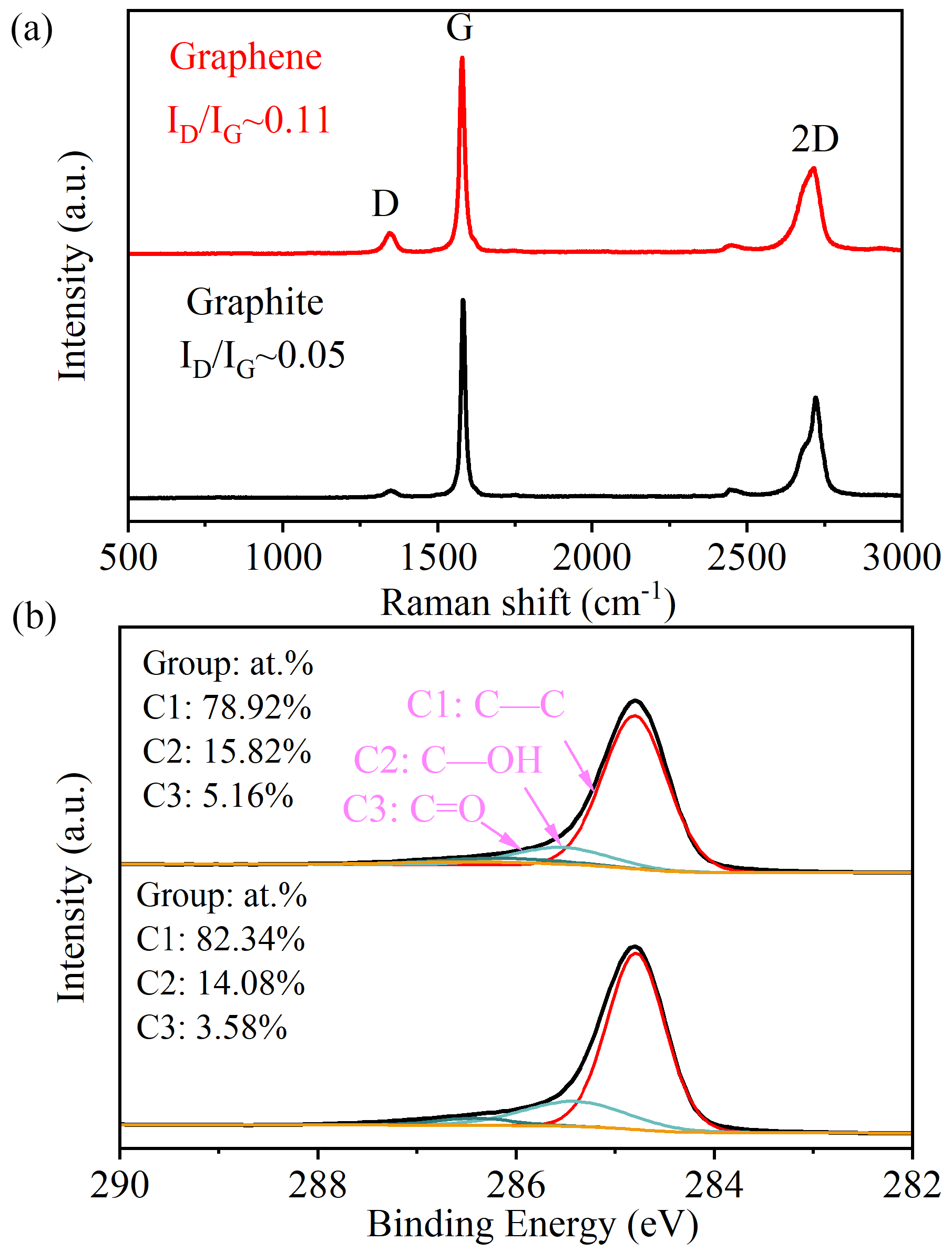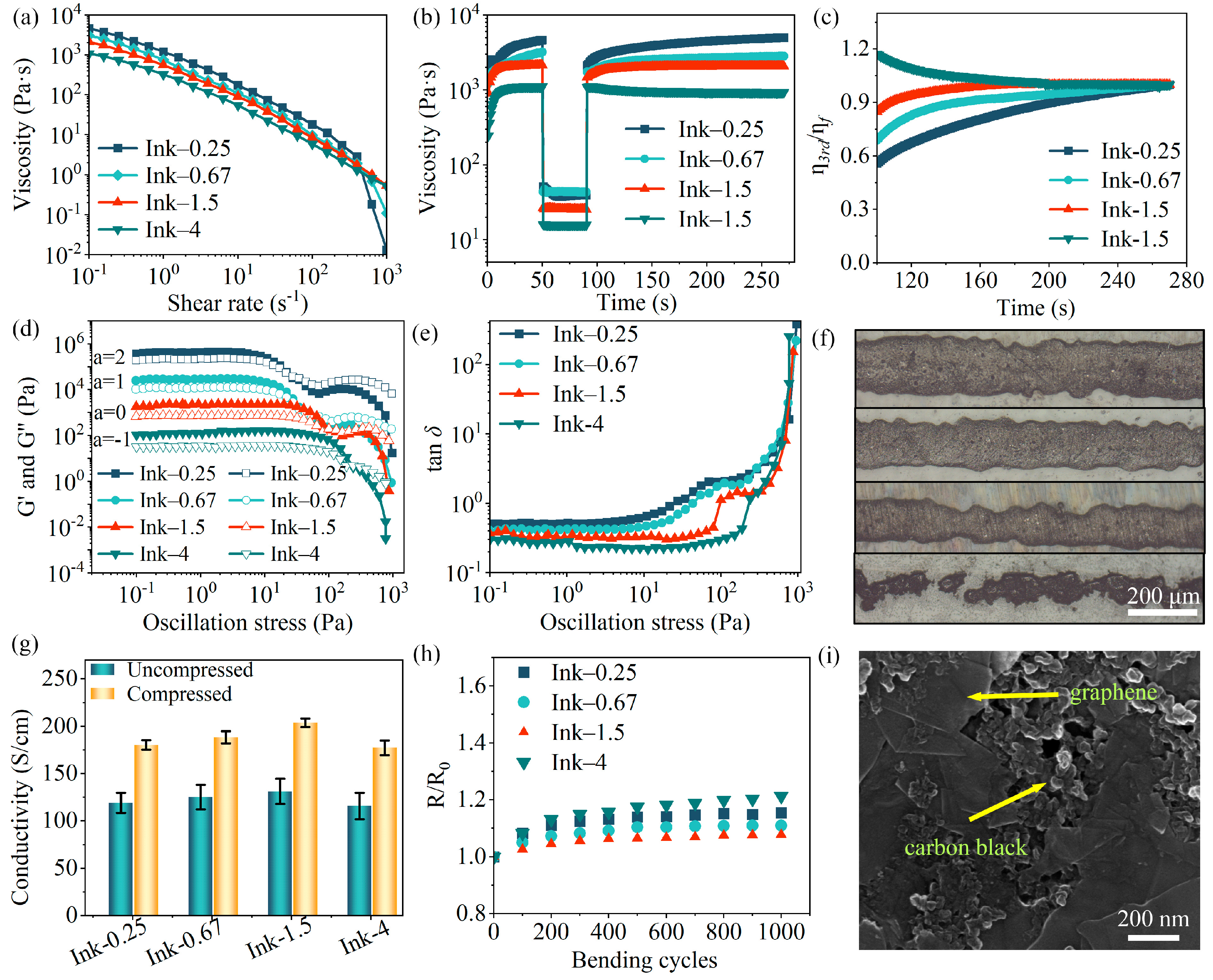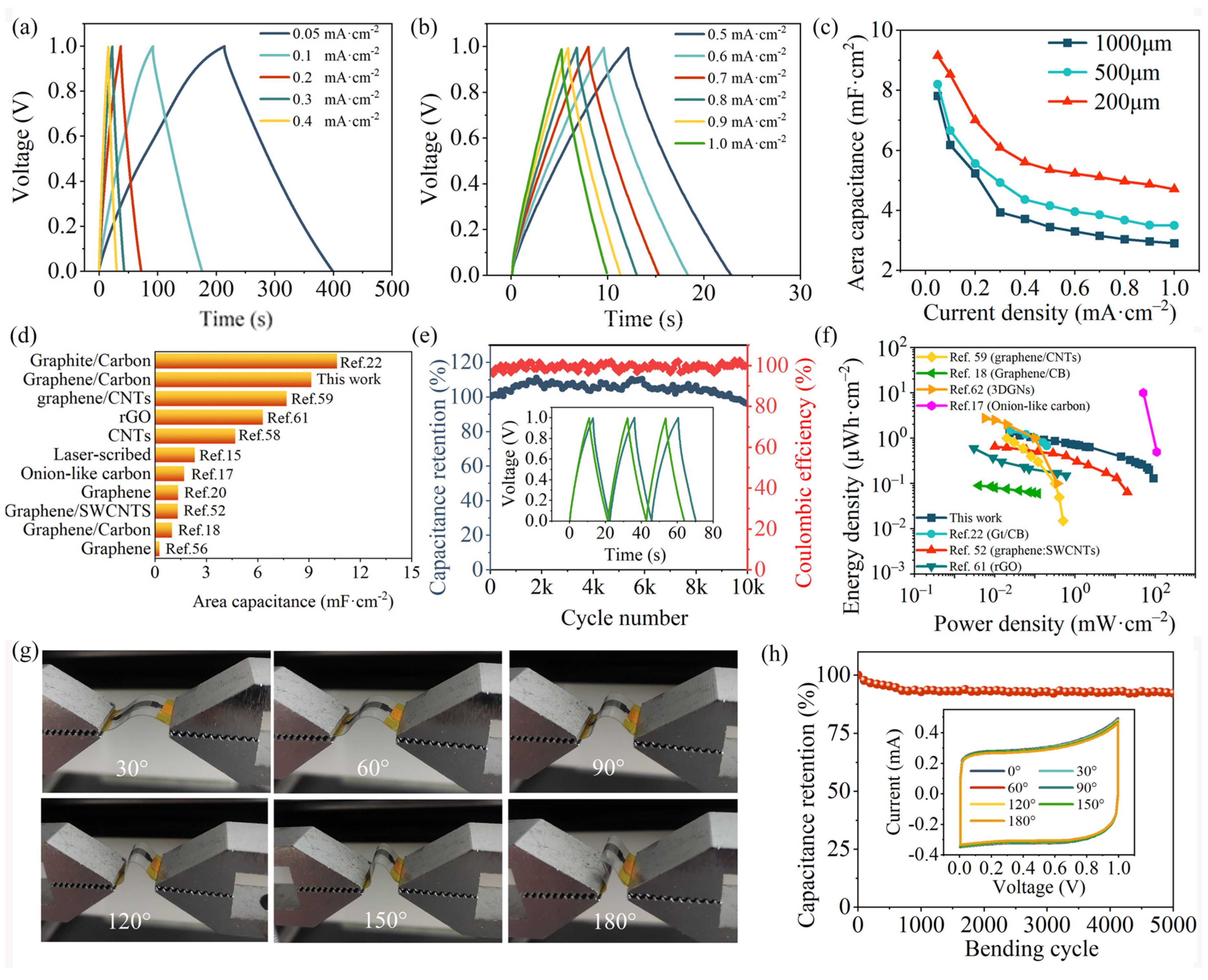Planar Micro-Supercapacitors with High Power Density Screen-Printed by Aqueous Graphene Conductive Ink
Abstract
:1. Introduction
2. Materials and Methods
2.1. Materials
2.2. Preparation of Aqueous Graphene Ink
2.3. Screen Printing of Inks and Assembly of Micro-Supercapacitors
2.4. Characterization
3. Results and Discussion
3.1. Morphology and Quality of Graphene
3.2. Rheological Behavior and Printing Performance of Graphene Inks
3.3. Electrochemical Performance of Micro-Supercapacitors
4. Conclusions
Supplementary Materials
Author Contributions
Funding
Institutional Review Board Statement
Informed Consent Statement
Data Availability Statement
Conflicts of Interest
References
- Simonenko, T.L.; Simonenko, N.P.; Gorobtsov, P.Y.; Simonenko, E.P.; Kuznetsov, N.T. Current Trends and Promising Electrode Materials in Micro-Supercapacitor Printing. Materials 2023, 16, 6133. [Google Scholar] [CrossRef] [PubMed]
- Hu, H.; Guo, Y.; Zhao, J. Manufacturing Shape-Controllable Flexible PEDOT/rGO Composite Electrodes for Planar Micro-Supercapacitors. Materials 2024, 17, 2144. [Google Scholar] [CrossRef]
- Czagany, M.; Hompoth, S.; Keshri, A.K.; Pandit, N.; Galambos, I.; Gacsi, Z.; Baumli, P. Supercapacitors: An Efficient Way for Energy Storage Application. Materials 2024, 17, 702. [Google Scholar] [CrossRef]
- Wang, Y.; Wu, X.; Han, Y.; Li, T. Flexible Supercapacitor: Overview and Outlooks. J. Energy Storage 2021, 42, 103053. [Google Scholar] [CrossRef]
- Liu, Q.; Zhang, G.; Chen, N.; Feng, X.; Wang, C.; Wang, J.; Jin, X.; Qu, L. The First Flexible Dual-Ion Microbattery Demonstrates Superior Capacity and Ultrahigh Energy Density: Small and Powerful. Adv. Funct. Mater. 2020, 30, 2002086. [Google Scholar] [CrossRef]
- Zschiebsch, W.; Sturm, Y.; Kucher, M.; Hedayati, D.P.; Behnisch, T.; Modler, N.; Böhm, R. Multifunctionality Analysis of Structural Supercapacitors—A Review. Materials 2024, 17, 739. [Google Scholar] [CrossRef]
- Qi, D.; Liu, Y.; Liu, Z.; Zhang, L.; Chen, X. Design of Architectures and Materials in In-Plane Micro-supercapacitors: Current Status and Future Challenges. Adv. Mater. 2017, 29, 1602802. [Google Scholar] [CrossRef]
- Balducci, A.; Dugas, R.; Taberna, P.L.; Simon, P.; Plée, D.; Mastragostino, M.; Passerini, S. High Temperature Carbon–Carbon Supercapacitor Using Ionic Liquid as Electrolyte. J. Power Sources 2007, 165, 922–927. [Google Scholar] [CrossRef]
- Largeot, C.; Portet, C.; Chmiola, J.; Taberna, P.-L.; Gogotsi, Y.; Simon, P. Relation between the Ion Size and Pore Size for an Electric Double-Layer Capacitor. J. Am. Chem. Soc. 2008, 130, 2730–2731. [Google Scholar] [CrossRef]
- Yu, Z.; Tetard, L.; Zhai, L.; Thomas, J. Supercapacitor Electrode Materials: Nanostructures from 0 to 3 Dimensions. Energy Environ. Sci. 2015, 8, 702–730. [Google Scholar] [CrossRef]
- Li, H.; Liu, S.; Li, X.; Wu, Z.-S.; Liang, J. Screen-Printing Fabrication of High Volumetric Energy Density Micro-Supercapacitors Based on High-Resolution Thixotropic-Ternary Hybrid Interdigital Micro-Electrodes. Mater. Chem. Front. 2019, 3, 626–635. [Google Scholar] [CrossRef]
- Wu, Z.-S.; Parvez, K.; Feng, X.; Müllen, K. Photolithographic Fabrication of High-Performance All-Solid-State Graphene-Based Planar Micro-Supercapacitors with Different Interdigital Fingers. J. Mater. Chem. A 2014, 2, 8288. [Google Scholar] [CrossRef]
- Sui, L.; Tang, S.; Dai, Z.; Zhu, Z.; Huangfu, H.; Qin, X.; Deng, Y.; Haarberg, G.M. Supercapacitive Behavior of an Asymmetric Supercapacitor Based on a Ni(OH)2/XC-72 Composite. New J. Chem. 2015, 39, 9363–9371. [Google Scholar] [CrossRef]
- Qu, Q.; Yang, S.; Feng, X. 2D Sandwich-like Sheets of Iron Oxide Grown on Graphene as High Energy Anode Material for Supercapacitors. Adv. Mater. 2011, 23, 5574–5580. [Google Scholar] [CrossRef] [PubMed]
- El-Kady, M.F.; Kaner, R.B. Scalable Fabrication of High-Power Graphene Micro-Supercapacitors for Flexible and on-Chip Energy Storage. Nat. Commun. 2013, 4, 1475. [Google Scholar] [CrossRef]
- Wu, Z.; Parvez, K.; Feng, X.; Müllen, K. Graphene-Based in-Plane Micro-Supercapacitors with High Power and Energy Densities. Nat. Commun. 2013, 4, 2487. [Google Scholar] [CrossRef]
- Pech, D.; Brunet, M.; Durou, H.; Huang, P.; Mochalin, V.; Gogotsi, Y.; Taberna, P.-L.; Simon, P. Ultrahigh-Power Micrometre-Sized Supercapacitors Based on Onion-like Carbon. Nat. Nanotechnol. 2010, 5, 651–654. [Google Scholar] [CrossRef] [PubMed]
- Shi, X.; Pei, S.; Zhou, F.; Ren, W.; Cheng, H.-M.; Wu, Z.-S.; Bao, X. Ultrahigh-Voltage Integrated Micro-Supercapacitors with Designable Shapes and Superior Flexibility. Energy Environ. Sci. 2019, 12, 1534–1541. [Google Scholar] [CrossRef]
- Hyun, W.J.; Secor, E.B.; Hersam, M.C.; Frisbie, C.D.; Francis, L.F. High-Resolution Patterning of Graphene by Screen Printing with a Silicon Stencil for Highly Flexible Printed Electronics. Adv. Mater. 2015, 27, 109–115. [Google Scholar] [CrossRef]
- Chen, H.; Zhang, Y.; Ma, Y.; Chen, S.; Wu, Y.; Lu, Y.; Ren, H.; Xin, S.; Bai, Y. Sand-Milling Exfoliation of Structure Controllable Graphene for Formulation of Highly Conductive and Multifunctional Graphene Inks. Adv. Mater. Interfaces 2021, 8, 2000888. [Google Scholar] [CrossRef]
- Chen, H.; Chen, S.; Zhang, Y.; Ren, H.; Hu, X.; Bai, Y. Sand-Milling Fabrication of Screen-Printable Graphene Composite Inks for High-Performance Planar Micro-Supercapacitors. ACS Appl. Mater. Interfaces 2020, 12, 56319–56329. [Google Scholar] [CrossRef] [PubMed]
- Wang, M.; Wang, J.; Wei, A.; Li, X.; Zhang, W.; Liu, Y. Highly Stable Aqueous Carbon-Based Conductive Ink for Screen-Printed Planar Flexible Micro-Supercapacitor. J. Alloys Compd. 2024, 976, 173125. [Google Scholar] [CrossRef]
- Tran, T.S.; Dutta, N.K.; Choudhury, N.R. Graphene Inks for Printed Flexible Electronics: Graphene Dispersions, Ink Formulations, Printing Techniques and Applications. Adv. Colloid Interface Sci. 2018, 261, 41–61. [Google Scholar] [CrossRef] [PubMed]
- Hua, C.; Li, X.; Shen, L.; Lei, H.; Guo, X.; Liu, Z.; Kong, Q.; Xie, L.; Chen, C.-M. Influence of Co-Solvent Hydroxyl Group Number on Properties of Water-Based Conductive Carbon Pastes. Particuology 2017, 33, 35–41. [Google Scholar] [CrossRef]
- Liang, J.; Jiang, C.; Wu, W. Printed Flexible Supercapacitor: Ink Formulation, Printable Electrode Materials and Applications. Appl. Phys. Rev. 2021, 8, 021319. [Google Scholar] [CrossRef]
- Wang, Y.; Zhang, X.; Liu, L.; Yi, M.; Shen, Z.; Li, K.; Zhu, Y. A High-Yield and Size-Controlled Production of Graphene by Optimizing Fluid Forces. J. Mater. Sci. 2023, 58, 13946–13956. [Google Scholar] [CrossRef]
- Shen, Z.; Li, J.; Yi, M.; Zhang, X.; Ma, S. Preparation of Graphene by Jet Cavitation. Nanotechnology 2011, 22, 365306. [Google Scholar] [CrossRef] [PubMed]
- Zhou, X.; Leng, T.; Pan, K.; Liu, Y.; Zhang, Z.; Li, J.; Novoselov, K.S.; Hu, Z. A Sustainable Approach towards Printed Graphene Ink for Wireless RFID Sensing Applications. Carbon 2024, 218, 118693. [Google Scholar] [CrossRef]
- Liu, L.; Shen, Z.; Zhang, X.; Ma, H. Highly Conductive Graphene/Carbon Black Screen Printing Inks for Flexible Electronics. J. Colloid Interface Sci. 2021, 582, 12–21. [Google Scholar] [CrossRef]
- Ma, H.; Shen, Z.; Yi, M.; Ben, S.; Liang, S.; Liu, L.; Zhang, Y.; Zhang, X.; Ma, S. Direct Exfoliation of Graphite in Water with Addition of Ammonia Solution. J. Colloid Interface Sci. 2017, 503, 68–75. [Google Scholar] [CrossRef]
- Malard, L.M.; Pimenta, M.A.; Dresselhaus, G.; Dresselhaus, M.S. Raman Spectroscopy in Graphene. Phys. Rep. 2009, 473, 51–87. [Google Scholar] [CrossRef]
- Dreyer, D.R.; Park, S.; Bielawski, C.W.; Ruoff, R.S. The Chemistry of Graphene Oxide. Chem. Soc. Rev. 2010, 39, 228–240. [Google Scholar] [CrossRef]
- Stankovich, S.; Dikin, D.A.; Piner, R.D.; Kohlhaas, K.A.; Kleinhammes, A.; Jia, Y.; Wu, Y.; Nguyen, S.T.; Ruoff, R.S. Synthesis of Graphene-Based Nanosheets via Chemical Reduction of Exfoliated Graphite Oxide. Carbon 2007, 45, 1558–1565. [Google Scholar] [CrossRef]
- Ferrari, A.C.; Meyer, J.C.; Scardaci, V.; Casiraghi, C.; Lazzeri, M.; Mauri, F.; Piscanec, S.; Jiang, D.; Novoselov, K.S.; Roth, S.; et al. Raman Spectrum of Graphene and Graphene Layers. Phys. Rev. Lett. 2006, 97, 187401. [Google Scholar] [CrossRef]
- Cançado, L.G.; Jorio, A.; Ferreira, E.H.M.; Stavale, F.; Achete, C.A.; Capaz, R.B.; Moutinho, M.V.O.; Lombardo, A.; Kulmala, T.S.; Ferrari, A.C. Quantifying Defects in Graphene via Raman Spectroscopy at Different Excitation Energies. Nano Lett. 2011, 11, 3190–3196. [Google Scholar] [CrossRef]
- Zhang, S.-L.; Zhang, Z.; Yang, W.-C. High-Yield Exfoliation of Graphene Using Ternary-Solvent Strategy for Detecting Volatile Organic Compounds. Appl. Surf. Sci. 2016, 360, 323–328. [Google Scholar] [CrossRef]
- Mitoma, N.; Nouchi, R.; Tanigaki, K. Photo-Oxidation of Graphene in the Presence of Water. J. Phys. Chem. C 2013, 117, 1453–1456. [Google Scholar] [CrossRef]
- Yi, M.; Shen, Z.; Ma, S.; Zhang, X. A Mixed-Solvent Strategy for Facile and Green Preparation of Graphene by Liquid-Phase Exfoliation of Graphite. J. Nanoparticle Res. 2012, 14, 1003. [Google Scholar] [CrossRef]
- Konios, D.; Stylianakis, M.M.; Stratakis, E.; Kymakis, E. Dispersion Behaviour of Graphene Oxide and Reduced Graphene Oxide. J. Colloid Interface Sci. 2014, 430, 108–112. [Google Scholar] [CrossRef] [PubMed]
- Hyun, W.J.; Lim, S.; Ahn, B.Y.; Lewis, J.A.; Frisbie, C.D.; Francis, L.F. Screen Printing of Highly Loaded Silver Inks on Plastic Substrates Using Silicon Stencils. ACS Appl. Mater. Interfaces 2015, 7, 12619–12624. [Google Scholar] [CrossRef] [PubMed]
- Qi, W.; Han, R.; Quan, H.; Guo, R.; Gao, D.; Zhou, Z.; Chen, G.-X.; Li, Q. Self-Reducing Molecular Ink for Printed Electronics and Lithium-Ion Battery Cathodes as Conductive Binder. J. Mater. Chem. C 2024, 12, 5114–5121. [Google Scholar] [CrossRef]
- Somalu, M.R.; Muchtar, A.; Daud, W.R.W.; Brandon, N.P. Screen-Printing Inks for the Fabrication of Solid Oxide Fuel Cell Films: A Review. Renew. Sustain. Energy Rev. 2017, 75, 426–439. [Google Scholar] [CrossRef]
- Perinelli, D.R.; Berardi, A.; Bisharat, L.; Cambriani, A.; Ganzetti, R.; Bonacucina, G.; Cespi, M.; Palmieri, G.F. Rheological Properties of Cellulosic Thickeners in Hydro-Alcoholic Media: The Science behind the Formulation of Hand Sanitizer Gels. Int. J. Pharm. 2021, 604, 120769. [Google Scholar] [CrossRef]
- Wagner, P.; Różańska, S.; Warmbier, E.; Frankiewicz, A.; Różański, J. Rheological Properties of Sodium Carboxymethylcellulose Solutions in Dihydroxy Alcohol/Water Mixtures. Materials 2023, 16, 418. [Google Scholar] [CrossRef]
- Stenner, R.; Matubayasi, N.; Shimizu, S. Gelation of Carrageenan: Effects of Sugars and Polyols. Food Hydrocolloids 2016, 54, 284–292. [Google Scholar] [CrossRef]
- Hu, G.; Kang, J.; Ng, L.W.T.; Zhu, X.; Howe, R.C.T.; Jones, C.G.; Hersam, M.C.; Hasan, T. Functional Inks and Printing of Two-Dimensional Materials. Chem. Soc. Rev. 2018, 47, 3265–3300. [Google Scholar] [CrossRef]
- Zavanelli, N.; Yeo, W.-H. Advances in Screen Printing of Conductive Nanomaterials for Stretchable Electronics. ACS Omega 2021, 6, 9344–9351. [Google Scholar] [CrossRef]
- Liang, J.; Tong, K.; Pei, Q. A Water-Based Silver-Nanowire Screen-Print Ink for the Fabrication of Stretchable Conductors and Wearable Thin-Film Transistors. Adv. Mater. 2016, 28, 5986–5996. [Google Scholar] [CrossRef] [PubMed]
- Gomez Vidales, A.; Kim, J.; Omanovic, S. Ni0.6-xMo0.4-xIrx-Oxide as an Electrode Material for Supercapacitors: Investigation of the Influence of Iridium Content on the Charge Storage/Delivery. J. Solid State Electrochem. 2019, 23, 2129–2139. [Google Scholar] [CrossRef]
- Gomez Vidales, A.; Sridhar, D.; Meunier, J.-L.; Omanovic, S. Nickel Oxide on Directly Grown Carbon Nanofibers for Energy Storage Applications. J. Appl. Electrochem. 2020, 50, 1217–1229. [Google Scholar] [CrossRef]
- Dinh, T.M.; Armstrong, K.; Guay, D.; Pech, D. High-Resolution on-Chip Supercapacitors with Ultra-High Scan Rate Ability. J. Mater. Chem. A 2014, 2, 7170–7174. [Google Scholar] [CrossRef]
- Bellani, S.; Petroni, E.; Del Rio Castillo, A.E.; Curreli, N.; Martín-García, B.; Oropesa-Nuñez, R.; Prato, M.; Bonaccorso, F. Scalable Production of Graphene Inks via Wet-Jet Milling Exfoliation for Screen-Printed Micro-Supercapacitors. Adv. Funct. Mater. 2019, 29, 1807659. [Google Scholar] [CrossRef]
- Zhang, Y.; Zhang, H.; Wang, X.; Shi, X.; Zhao, Z.; Wang, Y.; Liu, J.; Tang, C.; Wang, G.; Li, L. Graphene Nanoribbons Enhancing the Electronic Conductivity and Ionic Diffusion of Graphene Electrodes for High-Performance Microsupercapacitors. Energy Environ. Mater. 2023, 7, e12681. [Google Scholar] [CrossRef]
- Liu, W.; Lu, C.; Wang, X.; Tay, R.Y.; Tay, B.K. High-Performance Microsupercapacitors Based on Two-Dimensional Graphene/Manganese Dioxide/Silver Nanowire Ternary Hybrid Film. ACS Nano 2015, 9, 1528–1542. [Google Scholar] [CrossRef] [PubMed]
- Pech, D.; Brunet, M.; Dinh, T.M.; Armstrong, K.; Gaudet, J.; Guay, D. Influence of the Configuration in Planar Interdigitated Electrochemical Micro-Capacitors. J. Power Sources 2013, 230, 230–235. [Google Scholar] [CrossRef]
- Niu, Z.; Zhang, L.; Liu, L.; Zhu, B.; Dong, H.; Chen, X. All-Solid-State Flexible Ultrathin Micro-Supercapacitors Based on Graphene. Adv. Mater. 2013, 25, 4035–4042. [Google Scholar] [CrossRef]
- Hyun, W.J.; Secor, E.B.; Kim, C.; Hersam, M.C.; Francis, L.F.; Frisbie, C.D. Scalable, Self-Aligned Printing of Flexible Graphene Micro-Supercapacitors. Adv. Energy Mater. 2017, 7, 1700285. [Google Scholar] [CrossRef]
- Li, W.; Li, Y.; Su, M.; An, B.; Liu, J.; Su, D.; Li, L.; Li, F.; Song, Y. Printing Assembly and Structural Regulation of Graphene towards Three-Dimensional Flexible Micro-Supercapacitors. J. Mater. Chem. A 2017, 5, 16281–16288. [Google Scholar] [CrossRef]
- Yu, W.; Zhou, H.; Li, B.Q.; Ding, S. 3D Printing of Carbon Nanotubes-Based Microsupercapacitors. ACS Appl. Mater. Interfaces 2017, 9, 4597–4604. [Google Scholar] [CrossRef]
- Chih, J.-K.; Jamaluddin, A.; Chen, F.; Chang, J.-K.; Su, C.-Y. High Energy Density of All-Screen-Printable Solid-State Microsupercapacitors Integrated by Graphene/CNTs as Hierarchical Electrodes. J. Mater. Chem. A 2019, 7, 12779–12789. [Google Scholar] [CrossRef]
- Shi, X.; Wu, Z.; Qin, J.; Zheng, S.; Wang, S.; Zhou, F.; Sun, C.; Bao, X. Graphene-Based Linear Tandem Micro-Supercapacitors with Metal-Free Current Collectors and High-Voltage Output. Adv. Mater. 2017, 29, 1703034. [Google Scholar] [CrossRef] [PubMed]
- Shen, D.; Zou, G.; Liu, L.; Zhao, W.; Wu, A.; Duley, W.W.; Zhou, Y.N. Scalable High-Performance Ultraminiature Graphene Micro-Supercapacitors by a Hybrid Technique Combining Direct Writing and Controllable Microdroplet Transfer. ACS Appl. Mater. Interfaces 2018, 10, 5404–5412. [Google Scholar] [CrossRef] [PubMed]
- Kim, S.-W.; Kang, K.-N.; Min, J.-W.; Jang, J.-H. Plotter-Assisted Integration of Wearable All-Solid-State Micro-Supercapacitors. Nano Energy 2018, 50, 410–416. [Google Scholar] [CrossRef]







| Ink–0.25 | Ink–0.67 | Ink–1.5 | Ink–4 | |
|---|---|---|---|---|
| G′ (Pa) | 4208 | 2941 | 2048 | 1109 |
| G″ (Pa) | 2118 | 1246 | 715 | 330 |
| Tanδ (G″/G′) | 0.504 | 0.424 | 0.349 | 0.298 |
| τy (Pa) | 3.3 | 6.7 | 9.8 | 11.2 |
| τf (Pa) | 27.4 | 43.2 | 99.8 | 240.3 |
Disclaimer/Publisher’s Note: The statements, opinions and data contained in all publications are solely those of the individual author(s) and contributor(s) and not of MDPI and/or the editor(s). MDPI and/or the editor(s) disclaim responsibility for any injury to people or property resulting from any ideas, methods, instructions or products referred to in the content. |
© 2024 by the authors. Licensee MDPI, Basel, Switzerland. This article is an open access article distributed under the terms and conditions of the Creative Commons Attribution (CC BY) license (https://creativecommons.org/licenses/by/4.0/).
Share and Cite
Wang, Y.; Zhang, X.; Zhu, Y.; Li, X.; Shen, Z. Planar Micro-Supercapacitors with High Power Density Screen-Printed by Aqueous Graphene Conductive Ink. Materials 2024, 17, 4021. https://doi.org/10.3390/ma17164021
Wang Y, Zhang X, Zhu Y, Li X, Shen Z. Planar Micro-Supercapacitors with High Power Density Screen-Printed by Aqueous Graphene Conductive Ink. Materials. 2024; 17(16):4021. https://doi.org/10.3390/ma17164021
Chicago/Turabian StyleWang, Youchang, Xiaojing Zhang, Yuwei Zhu, Xiaolu Li, and Zhigang Shen. 2024. "Planar Micro-Supercapacitors with High Power Density Screen-Printed by Aqueous Graphene Conductive Ink" Materials 17, no. 16: 4021. https://doi.org/10.3390/ma17164021








